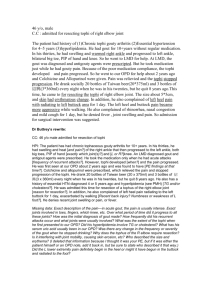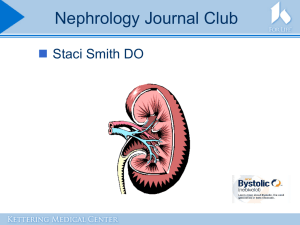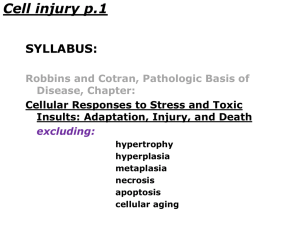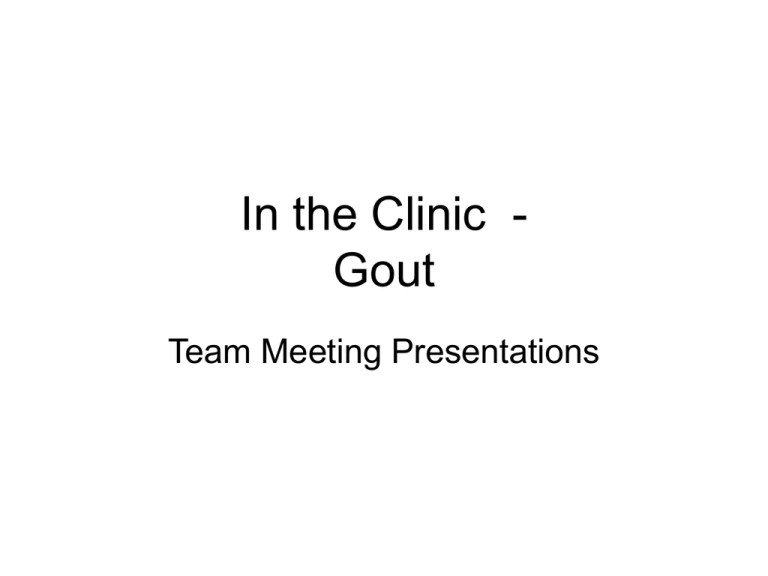
In the Clinic Gout
Team Meeting Presentations
Risk Factors for Gout
•
•
•
•
•
•
•
•
•
•
Hyperuricemia
Male sex if <60
Obesity
High purine diet (red meat; shellfish)
Alcohol (esp beer and spirits) and high fructose drinks
Medications (thiazides; cyclosporine)
CKD
Lead exposure
Organ transplantation
Specific diseases (htn, DM, hyperlipidemia, hematologic
malignancies; genetics
Are there effective strategies for
primary prevention of gout?
• Dietary modifications, weight loss
• Pharmacologic therapy is not recommended
when hyperuricemia is assymptomatic
• Pharmocologic therapy is recommended in pts
on chemo for hematologic malignancies
– Uric acid lowering drugs and hydration prevent
secondary gout due to tumor lysis
– Without this treatment, uric acid nephropathy with
tubular obstruction can develop
Is gout associated with increased risk for CV
disease and can this be prevented?
• Both CV disease and gout are associated
with serum markers of inflammation
• CV disease risk is increased in persons
with gout or hyperuricemia
• Opinions differ on whether the association
of an elevated serum urate level with
increased CV disease is modifiable
What symptoms and physical
findings suggest gout?
• Warmth, swelling, redness and severe
joint pain
• Of first attacks, 90% are monoarticular
• Common sites of crystal deposition, tophus
development: helix of the ear, lower extremities
• Other sites: periarticular structures (bursae,
tendons)
• Crystals are more likely in previously diseased
joints
• Other forms of arthritis increase gout risk
Symptoms and Findings
• Episodic self-limited joint pain, swelling,
erythema
• Attacks often occur at night or in early
morning
• Trauma may trigger release of crystals into
joint space
• Attacks often subside in 3-14 days without
treatment
Tests to Diagnose Gout
• Serum urate level- may be normal in acute
flare
• CBC with differential
• Synovial fluid or tophus aspirate
examination
– Polarizing scope, cell count culture
• Radiography – to r/o other causes or for
findings suggestive of chronic gout
Podagra
Uric Acid Crystals
Radiograph – chronic gout
Value of radiography in the
diagnosis of gout
• Early in course- to r/o other conditions
• Later in course – can show prominent,
proliferative bony reaction
• Gout related tophi cause bone destruction away
from the joint
• Gout less likely to cause joint space narrowing
than psoriatic arthritis or rheumatoid arthritis
Differential Diagnosis of Gout
• Rheumatoid arthritis
• Symmetrical polyarthritis in small joints of hands
and feet
• Hand involvement more likely than in gout
• Subcutaneous nodules in 20%
• XRAY – soft tissue swelling; diffuse joint space
narrowing, marginal erosions of small joints,
osteopenia
Differential Diagnosis of Gout
• Pseudogout – calcium pyrophosphate
deposition disease
• Appears in unusual places - elbows, wrists –
without trauma
• Affects 10-15% >65
• XRAY – looks like RA or osteoarthritis but with
bony repair
• Cartilage calcification
• Triangular cartilage - pathognomonic
Differential Dx of Gout – cont’d
• Septic Arthritis –
•
•
•
•
Fever, arthritis, great tenderness
Up to ½ have concomitant RA
Source is often evident
Diagnose and treat immediately to avoid joint destruction
Differential Diagnosis Gout- Cont’d
• Cellulitis – gout often mistaken for cellulitis
also
• Erythema, swelling of the extremity, very tender,
febrile
• Often previous surgery or infection at the site
• Xray – soft tissue swelling
• Staph/strep most likely
Differential Dx- Gout – Cont’d
• Osteoarthritis – bony enlargement without signif
inflammation – usually – May often involve the
halus valgus – as in gout
• Psoriatic arthritis – DIP’s often, nail changes –
XRAY central erosions, subchondral sclerosis,
bony repair signs;uric acid levels might be high
due to proliferative skin changes
• Sarcoidosis – acute disease can involve ankles
– look for subcut nodules, erythema nodosum
– Assoc parotits, uveitis, hilar adenopathy, lung
involvement
When to consider hospitalizing a
patient with gout?
• To distinguish gout from septic arthritis
– Joint fluid analysis
– Empiric antibiotics until diagnosis is clear
– Repeated synovial fluid analysis if needed for
culture, urate crystals, cell counts
• To control pain
Aspiration of joint fluid may help
Gout is one of the most painful conditions
Non Drug Therapy in Gout
•
•
•
•
•
•
Reduce high purine foods in diet
Reduce alcohol and high fructose drinks
Weight loss – to decrease urate levels
Hydration
Diet high in fiber, vitamin C, folate
Replace medications that reduce uric acid
excretion whenever possible
Diet Issues
• High purine animal and fish sources
• Red meat, meat extracts, organ meats, seafood
• Yeast products – baked goods and beer
• Mushrooms, spinach, asparagus,
cauliflower
• Legumes – peas, dried beans
Drugs for Acute Gout
• NSAIDS
• First line –analgesic/antiinflammatory
• Ibuprofen and Naproxen better tolerated than indomethacin; don’t use
aspirin
• Start at higher dose and taper over 1 week
• Side effects as usual
• Caution in elderly
• Don’t use in anticoagulated patients
• Colchicine (oral)
• Most effective if started 12-36 hours after onset
• Lower doses reduce side effects (0.6 mg tid)
• Side effects – GI, bone marrow suppression, myopathy, neuropathy,
dermatitis, urticaria, alopecia, purpura
• Myelosuppression can be severe at high doses; reduced with a short course
• Caution when using other CYP3A4 inhibitors
• Reduce dose for renla or hepatic dysfunction; avoid if on dialysis
• Caution in elderly
Drugs for Acute Gout
• Corticosteroids (oral)
• For polyarticular gout when NSAIDS contraindicated
• Side effects
• Corticosteroids (intraartiular injection)
• For monoarticular gout when NSAIDS not ideal
• Side effects – risk for damage to nerves, tendons, vascular
structures; joint infection risk; usual oral steroid risks
• Rule out infectious cause before injecting join
• Opiates –
•
•
•
•
For severe pain
Oral combinations of oxycodone, hydrocodone, codeine
Severe cases – morphine IV or SC
Short term - until inflammation resolved
Drugs to Prevent Gout and
Complications of Hyperuricemia
• To prevent growth of crystalliine deposits
• Deposits can lead to chronically stiff, swollen joints and
debilitating arthritis
• To reduce tophi
• To prevent flare recurrence
• 60% flare again in 1 year, 78% within 2
• Subsequent attacks may last longer, involve more joints
• To prevent uric acid stones
• Occurs in 10-40% of persons with gout
• Goal is to reduce urate <6 mg/dl
Drugs to prevent gout and
complications of hyperuricemia
• Allopurinol
• Start 100-200 mg/d, increase by 100 mg.d every 1-4 weeks;
reduced dose for CKD
• Not in acute attack, concurrent colchicine may reduce risk for
flare
• Watch for hypersensitivity syndrome
• Other side effects – rash, fever, headache, uritcaria,
interstitial nephritis
• LFTs and CBC monitored
• Febuxostat
•
•
•
•
Start 40-80 mg/d; increase to achieve goal urate level
Steady state urate after 2 week use
LFT abn, diarrhea, headache, nausea, rash
No dose adjustment needed in mild to mod CKD
Other Drugs to reduce Uric acid
level
• Rasburicase
• To prevent tumor lysis
• Not if G6PD deficient
• Start 24 hours before chemo
• Probenicid
• 0.5-2 mg /day divided 2X/day, dose adjust until urate level
normalizes
• Uricosuric – use only if underexreter
• Don’t use with aspirin
• Increases methotrexate toxicity
• Rare anaphylaxis
• Not effective in pts with signif CKD
Drugs to prevent Gouty attacks
• Colchicine (oral)
• Dose and use depends on cr clearance; avoid if <10 ml/min
• Continue for 6 months after serum urate <6 or until tophi
disappear
• Use caution with other CYP3A4 inhibitors
• May need to dose reduce with calcium channel blockers
• Side effects GI intolerance, bone marrow suppression,
dermatitis, urticaria, alopecia, purpura
• Myopathy, neuropathy may increase with renal disease or
with statin use
• Avoid in severe liver disease
Indications for long term drug therapy
to prevent gout and complications of
hyperuricemia
•
•
•
•
At least 2-3 acute attacks of gout
Tophaceous gout
Severe attacks or polyarticular attacks
Radiographic evidence of joint damage
from gout
• Nephrolithiasis
• Identifiable inborn metabolic deficiency
causing hyperuricemia
When to think about referring for
specialty consultation…
• Consult with a rheumatologist or orthopedist
•
•
•
•
•
When joint sepsis is suspected
When gout is poorly controlled
When diagnosis is unclear
When gout occurs with other forms of arthritis
To aid in deciding on timing of initiation of meds or
complicated regimens
• Consult with rheum in pts with inherited
metabolic disease for patients aged <20 with
gout
• Consult with nephrologist for help managing pts
with CKD and/or urate nephropathy

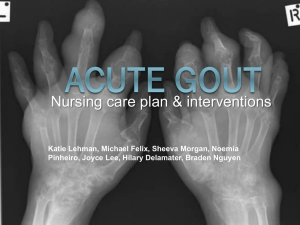
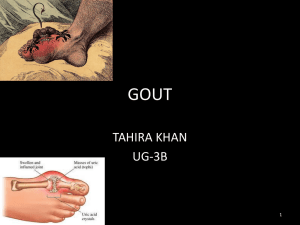
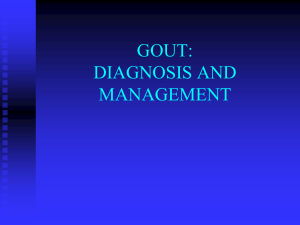
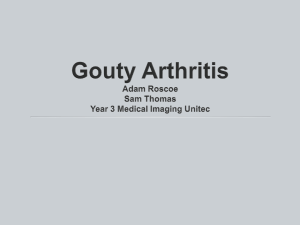
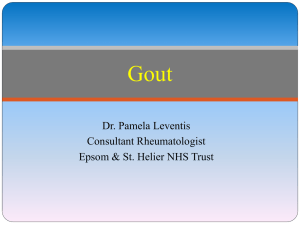
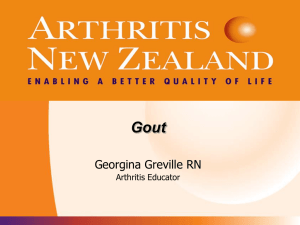
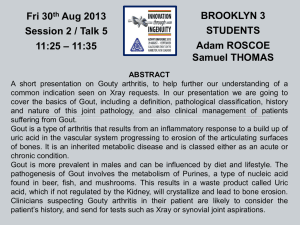
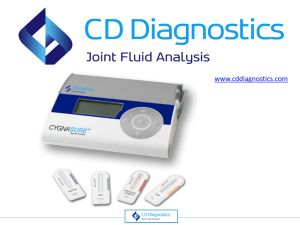
![06Gout_-_Copy[1].](http://s2.studylib.net/store/data/005758926_1-0d7c6513b0c82c14c18839741770ea53-300x300.png)
